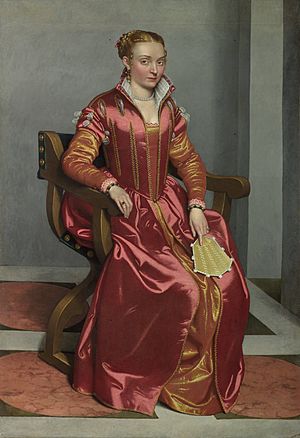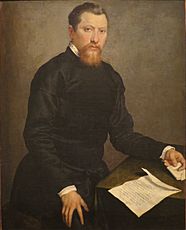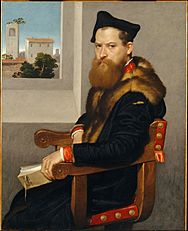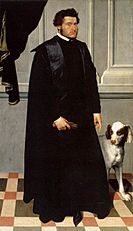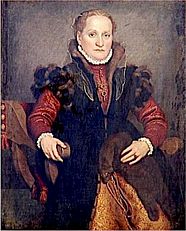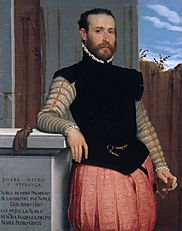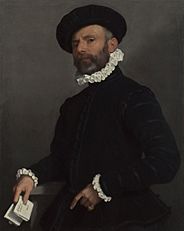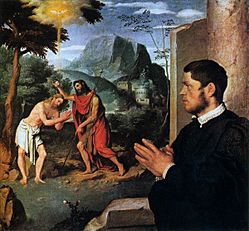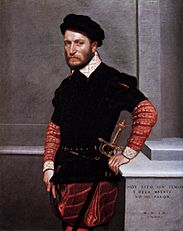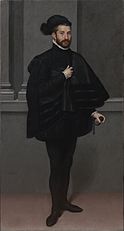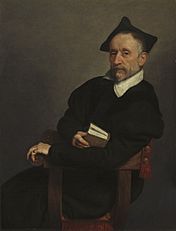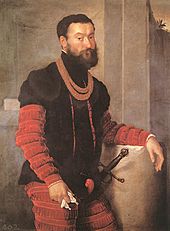Giovanni Battista Moroni facts for kids
Giovanni Battista Moroni (born around 1520-1524, died 1578) was a famous Italian painter from the time of the Late Renaissance. He is also known as Giambattista Moroni. He was best known for his very real and elegant paintings of important people, like nobles and church leaders. Many consider him one of the greatest portrait painters of the 1500s (also called the Cinquecento).
About Giovanni Battista Moroni
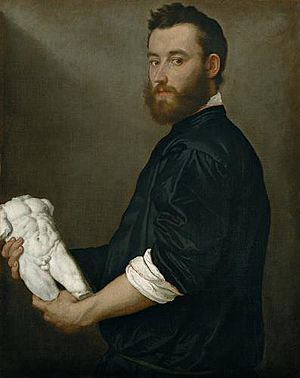
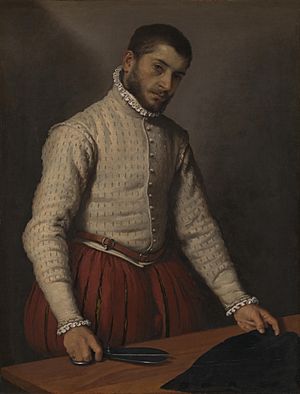
Giovanni Battista Moroni was the son of an architect named Andrea Moroni. He learned to paint from Alessandro Bonvicino, also known as "Il Moretto," in Brescia. Moroni was his main helper in the 1540s.
He worked in different cities like Trento, Bergamo, and his hometown of Albino, near Bergamo. He was born and died in Albino. Moroni spent two short periods in Trento, which happened during the first two meetings of the Council of Trent (1546–1548 and 1551–1553). During these times, he painted many religious artworks. He also created the series of portraits that he is famous for today.
While in Trento, Moroni met the famous painter Titian. He also met Count-Bishop Cristoforo Madruzzo. Titian painted Madruzzo's portrait, but Moroni painted portraits of Madruzzo's sons. Some people in the 1800s thought Moroni trained with Titian. However, it's not likely he spent much time in Titian's studio.
Moroni became a very popular portrait painter in Bergamo. This period was quite short, lasting only from about 1557 to 1562. After this, Bergamo faced local troubles, and Moroni moved back to Albino permanently. Because he was in a smaller town, the famous writer Giorgio Vasari didn't mention him in his writings about artists.
During his time in Bergamo, Moroni created many portraits. He was influenced by the realistic style of another artist, Savoldo. His portraits showed people with dignity and looked like they were part of everyday life. He didn't just paint rich nobles. He also painted scholars, professionals, and government workers. He paid close attention to details like clothes and objects in his paintings.
Moroni also painted religious scenes, but these were not as successful as his portraits. These paintings were for people in the nearby valleys who might not have been as interested in complex art. For example, he painted a Last Supper for a church in Romano. He also painted a Coronation of the Virgin in Bergamo. Moroni was working on a Last Judgment painting when he died. His religious paintings show influences from his teacher, Lorenzo Lotto, and Girolamo Savoldo.
Even though his religious paintings sometimes looked a bit old-fashioned, his portraits were amazing. They showed deep understanding of people's feelings, looked very natural, and had beautiful, soft colors. People who ordered religious art wanted classic, holy figures, not individualized ones. But for portraits, they loved seeing themselves and others painted in a lively, real way.
Where to See Moroni's Art
The National Gallery in London has one of the best collections of Moroni's work. This includes his famous portrait known as Il sarto (The Tailor). You can find other portraits in the Uffizi Gallery in Florence, the Berlin Gallery, and the National Gallery of Art in Washington, D.C.
Many other public art collections around the world also have paintings by Giovanni Battista Moroni. These include:
- The Accademia Carrara (Bergamo)
- The Ashmolean Museum (Oxford)
- The Detroit Institute of Arts
- The Hermitage Museum
- The Honolulu Museum of Art
- The Kunsthistorisches Museum (Vienna)
- The Musée du Louvre (Paris)
- The Metropolitan Museum of Art (New York)
- The National Gallery of Canada
- The Rijksmuseum
- The John and Mable Ringling Museum of Art
- The Virginia Museum of Fine Arts
- The National Gallery of Ireland
- The Prado Museum (Madrid)
- The Worcester Art Museum
In 2016, a painting called "Portrait of a Man," which was thought to be from Moroni's workshop, was returned to the family of Dr. August Liebmann Mayer. This painting had been taken by the Nazis during World War II. It was returned to France and kept at the Louvre Museum since 1951 before being given back to its rightful owners.
Gallery
-
Portrait of a Man, oil on canvas, 1553, Honolulu Museum of Art
-
Portrait of Bartolomeo Bonghi, oil on canvas, 1553, Metropolitan Museum of Art
-
Portrait of Don Gabriel de la Cueva, 1560, Gemäldegalerie, Berlin
-
Portrait of a Soldier, circa 1560, Prado Museum, Madrid
See also
 In Spanish: Giovanni Battista Moroni para niños
In Spanish: Giovanni Battista Moroni para niños


